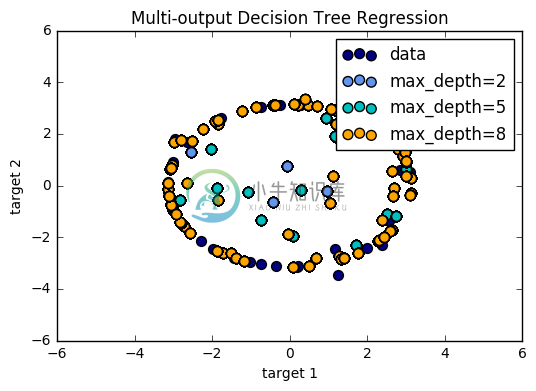决策树 Decision_trees - Ex 2: Multi-output Decision Tree Regression
优质
小牛编辑
146浏览
2023-12-01
决策树/范例二:Multi-output Decision Tree Regression
http://scikit-learn.org/stable/auto_examples/tree/plot_tree_regression_multioutput.html
范例目的
此范例用决策树说明多输出迴归的例子,利用带有杂讯的特征及目标值模拟出近似圆的局部线性迴归。
若决策树深度越深(可由max_depth参数控制),则决策规则越复杂,模型也会越接近数据,但若数据中含有杂讯,太深的树就有可能产生过拟合的情形。
此范例模拟了不同深度的树,当用带有杂点的数据可能造成的情况。
(一)引入函式库及建立随机数据资料
引入函式资料库
matplotlib.pyplot:用来绘制影像。sklearn.tree import DecisionTreeRegressor:利用决策树方式建立预测模型。
特征资料
np.random():随机产生介于0~1之间的乱数RandomState.rand(d0,d1,..,dn):给定随机乱数的矩阵形状np.sort将资料依大小排序。
目标资料
np.sin(X):以X做为径度,计算出相对的sine值。ravel():输出连续的一维矩阵。y[::5, :] += (0.5 - rng.rand(20, 2)):为目标资料加入杂讯点。
import numpy as npfrom sklearn.tree import DecisionTreeRegressorimport matplotlib.pyplot as pltrng = np.random.RandomState(1)X = np.sort(200 * rng.rand(100, 1) - 100, axis=0) #在-100~100之间随机建立100个点y = np.array([np.pi * np.sin(X).ravel(), np.pi * np.cos(X).ravel()]).T #每个X产生两个输出分别为sine及cosine值,并存于y中y[::5, :] += (0.5 - rng.rand(20, 2)) #每5笔资料加入一个杂讯
(二)建立Decision Tree迴归模型
建立模型
DecisionTreeRegressor(max_depth = 最大深度):DecisionTreeRegressor建立决策树回归模型。max_depth决定树的深度,若为None则所有节点被展开。此范例会呈现不同max_depth对预测结果的影响。
模型训练
fit(特征资料, 目标资料):利用特征资料及目标资料对迴归模型进行训练。
预测结果
np.arrange(起始点, 结束点, 间隔):np.arange(-100.0, 100.0, 0.01)在-100~100之间每0.01取一格,建立预测输入点矩阵。np.newaxis:增加矩阵维度。predict(输入矩阵):对训练完毕的模型测试,输出为预测结果。
# Fit regression modelregr_1 = DecisionTreeRegressor(max_depth=2) #最大深度为2的决策树regr_2 = DecisionTreeRegressor(max_depth=5) #最大深度为5的决策树regr_3 = DecisionTreeRegressor(max_depth=8) #最大深度为8的决策树regr_1.fit(X, y)regr_2.fit(X, y)regr_3.fit(X, y)# PredictX_test = np.arange(-100.0, 100.0, 0.01)[:, np.newaxis]y_1 = regr_1.predict(X_test)y_2 = regr_2.predict(X_test)y_3 = regr_3.predict(X_test)
(三) 绘出预测结果与实际目标图
plt.scatter(X,y):将X、y以点的方式绘制于平面上,c为数据点的颜色,s决定点的大小,label为图例。
plt.figure()s = 50plt.scatter(y[:, 0], y[:, 1], c="navy", s=s, label="data")plt.scatter(y_1[:, 0], y_1[:, 1], c="cornflowerblue", s=s, label="max_depth=2")plt.scatter(y_2[:, 0], y_2[:, 1], c="c", s=s, label="max_depth=5")plt.scatter(y_3[:, 0], y_3[:, 1], c="orange", s=s, label="max_depth=8")plt.xlim([-6, 6]) #设定x轴的上下限plt.ylim([-6, 6]) #设定y轴的上下限plt.xlabel("target 1") #x轴代表target 1数值plt.ylabel("target 2") #x轴代表target 2数值plt.title("Multi-output Decision Tree Regression") #标示图片的标题plt.legend() #绘出图例plt.show()

(四)完整程式码
print(__doc__)import numpy as npimport matplotlib.pyplot as pltfrom sklearn.tree import DecisionTreeRegressor# Create a random datasetrng = np.random.RandomState(1)X = np.sort(200 * rng.rand(100, 1) - 100, axis=0)y = np.array([np.pi * np.sin(X).ravel(), np.pi * np.cos(X).ravel()]).Ty[::5, :] += (0.5 - rng.rand(20, 2))# Fit regression modelregr_1 = DecisionTreeRegressor(max_depth=2)regr_2 = DecisionTreeRegressor(max_depth=5)regr_3 = DecisionTreeRegressor(max_depth=8)regr_1.fit(X, y)regr_2.fit(X, y)regr_3.fit(X, y)# PredictX_test = np.arange(-100.0, 100.0, 0.01)[:, np.newaxis]y_1 = regr_1.predict(X_test)y_2 = regr_2.predict(X_test)y_3 = regr_3.predict(X_test)# Plot the resultsplt.figure()s = 50plt.scatter(y[:, 0], y[:, 1], c="navy", s=s, label="data")plt.scatter(y_1[:, 0], y_1[:, 1], c="cornflowerblue", s=s, label="max_depth=2")plt.scatter(y_2[:, 0], y_2[:, 1], c="c", s=s, label="max_depth=5")plt.scatter(y_3[:, 0], y_3[:, 1], c="orange", s=s, label="max_depth=8")plt.xlim([-6, 6])plt.ylim([-6, 6])plt.xlabel("target 1")plt.ylabel("target 2")plt.title("Multi-output Decision Tree Regression")plt.legend()plt.show()

